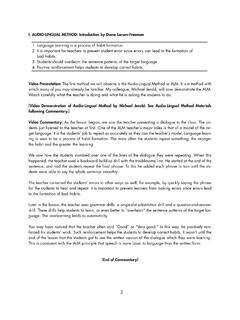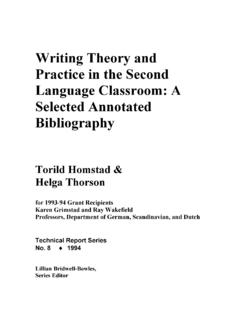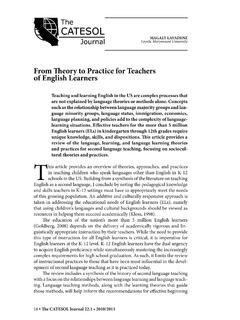Transcription of ACTIVITIES TO SUPPORT MULTILINGUALISM AT SCHOOL
1 TO SUPPORTMULTILINGUALISM AT SCHOOLHOW TO MOTIVATE CHILDREN TO USE LANGUAGES salamTEREприветTEACHER S GUIDE Version supportmultilingualismat homeactivitiesto supportmultilingualism at for parentsintro forteacherspedagogical backgrounde-storybook0-6e-storybook6-10e -storybook6-10repositoryMultilingual Families Mapactivitiesto supportmultilingualismat project has been funded with SUPPORT from the European Commission. This publication reflects the views only of the author, and the Commission cannot be held responsible for any use which may be made of the information contained therein. CONTENTS PREFACE .. 2 INTRODUCTION TO THE ACTIVITIES .. 3 INDEX OF ACTIVITIES .. 4 GLOSSARY OF TERMS .. 31 BIBLIOGRAPHY .. 32 AUTHORS .. 33 This project has been funded with SUPPORT from the European Commission.
2 This publication reflects the views only of the author, and the Commission cannot be held responsible for any use which may be made of the information contained therein. PREFACE Dear nursery educator and teacher, On the following pages you will find 26 ACTIVITIES for children created by the authors of Multi- lingual Families. You can use them for group work to involve the participants in the program, so that they can gain a new skill through an experience, solidify new knowledge and insights and work on the development of their personality in collabo-ration with others. The ACTIVITIES are designed to represent an adequate SUPPORT for multilingual children by highlighting the benefits of the ability to speak multiple languages, to interest other children in languages and to reinforce the re-spect, curiosity and desire for further knowledge by all participants.
3 ACTIVITIES are designed to lead to the immediate acquisition of new skills. It is a process which is effective and its effects are long-lasting. Practice helps to consolidate the acquired knowledge in memory, thus it creates a new experience and consequently a skill. Important elements to ac-quire new skills are: Motivation desire to discover new things, thirst for knowledge, curiosity. Safe environment helps to prevent a sense of shame, embarrassment and insecurity. It is an environment in which children are not afraid to be whom they really are and where they are not afraid to show their feelings in front of others. They can thus obtain valuable information from others and they are not afraid to accept others. Solidarity with others supports children creativ-ity, their willingness to take risks, venturing into new situations and competing with others.
4 It cre-ates a sense of safety and security, the joy of shar-ing experiences, impressions which they can share with others and as a result, enriches one another. Enjoyment is a side effect of the situation, when children are successful, they feel content, they can work together to discover and acquire situa-tions when children enjoy new experiences with others and feel good. The ACTIVITIES in this collection can be used as they stand but, of course, they can also serve as an inspi-ration to create your own ideas so that they suit your own context or the wishes or preferences of you and your children. We wish you and your students success in working with the ACTIVITIES , much mutually enriching experi-ences, and fulfilment with the result achieved. Authors This project has been funded with SUPPORT from the European Commission.
5 This publication reflects the views only of the author, and the Commission cannot be held responsible for any use which may be made of the information contained therein. INTRODUCTION TO THE ACTIVITIES The Multilingual Families project ACTIVITIES are designed to help teachers to maximize the motivation of their students from families with more than one language to raise their children to learn and retain their family lan-guages. They also will arouse the children s interest in language and to promote MULTILINGUALISM in a stimulat-ing and fun environment. The practical implementation of the material is designed to raise the awareness of the linguistic and multi-cultural diversity of Europe through creative, playful methods and to promote MULTILINGUALISM in children of pre- and primary SCHOOL age.
6 Not only MULTILINGUALISM is promoted, but also the inter-est in intercultural communication. In order to prevent the social exclusion of children whose native language is different from the national language, the ACTIVITIES pro-vide incentives to learn other languages and convey that learning languages is fun and that knowing more lan-guages has great value. Children are interested in languages and motivated to learn, but often do not know how to proceed without help from parents, relatives or other adults. Children who are multilingual can also be held up as an example that the ability to speak several languages is achievable. In addition to the present instructions, educators can make use of the ACTIVITIES in many different ways. They can let their creativity run free.
7 The ACTIVITIES offer a clear system where you can under-stand how to deal, from a motivational aspect, with the different issues present within multilingual education. The ACTIVITIES were not regimented or consistent by the length of each entry. This was felt to be a forced ap-proach and it was not appropriate to try to expand sim-pler ACTIVITIES just to fill space or to truncate more com-plicated ACTIVITIES to achieve uniformity. All ACTIVITIES have the same structure. We include the age group that the activity is suitable for, its objectives and duration. The procedure for the implementation of each activity is carefully described step by step, to allow for simple use in the classroom. You will also find the expected skills that the activity builds and strengthens. The ACTIVITIES can easily be integrated into the educa-tional daily routine of the nursery groups and classes in schools.
8 HOW TO USE THIS BROCHURE To make it easy to understand the ACTIVITIES they all fol-low the same structure: DURATION: the time needed for each activity. AGE RECOMMENDATION: the target groups of each activity, which are 0 6 and 6 10 years. KEY WORDS: the main objectives, the contents and methods of each activity. LANGUAGES OF THE ORIGINAL SOURCE: the materi-als are authentic good practice , collected from dif-ferent partners of Multilingual Families and therefore they have different languages of origin. In order to al-low as many schools and kindergartens as possible to use these materials you ll find translations, if needed, in the 17 languages of Multilingual Families. Also some more, if parents or educators offered them, see Most of the ACTIVITIES can be used in any language. MATERIALS NEEDED: all the materials needed for car-rying out an activity.
9 AIM OF THE ACTIVITY: the aims of the activity. You will also find the expected outcomes of ACTIVITIES , with the focus on skills that the activity builds and strengthens. PREPARATION FOR THE ACTIVITY: all preparatory steps necessary, before you should do an activity. PROCEDURE: each activity is carefully described with a step by step, guide to allow for easy use. Feel free to adapt the procedure or add your own ideas. If you want to share your ideas with others, please join us at SIGNIFICANT BENEFIT OF THE ACTIVITY: the signifi-cant benefit of the activity is a single sentence. It is the added value of the activity and you can also find a link to theoretical information, why this activity or category is supportive to language development.
10 SOURCE OF THE ACTIVITY: the source of every activi-ty is fully cited. All words that are asterisked are defined in the Glossary on page 31. This project has been funded with SUPPORT from the European Commission. This publication reflects the views only of the author, and the Commission cannot be held responsible for any use which may be made of the information contained therein. INDEX OF ACTIVITIES NR. TITLE AGE GROUP KEYWORDS DESCRIPTION A1 FROLICKING WITH THE RHYME 6 10 rhymes, comprehension, content Work with poems in different languages. A2 LET S GO ON MY HOLIDAY 6 10 holiday, photos, imagination, souve-nirs, culture Your favourite holiday description. A3 CLAP THE WORD FOR FUN 6 10 audio, handclap, recording, sound Foreign words identification. A4 MOVE YOUR BODY! 0 6 body, describing, movement, picture of human body Language acquisition using human body.


![arXiv:2006.13979v2 [cs.CL] 15 Dec 2020](/cache/preview/5/9/1/6/a/e/7/c/thumb-5916ae7cfe9f0a2ccc8f0f1087f6087d.jpg)
